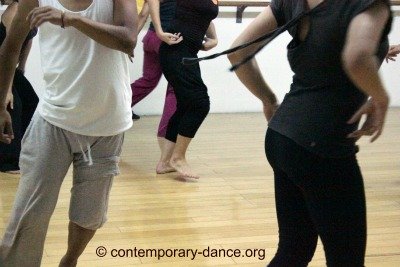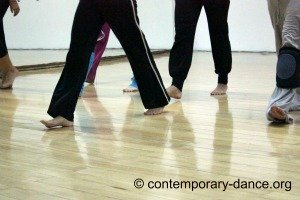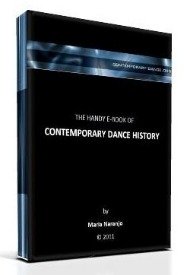FLYING LOW AND PASSING THROUGH
Flying low is a contemporary dance training style developed by the Venezuelan dancer and choreographer David Zambrano. In such a dancing class you will be asked to copy and repeat different series of exercises, like if you were learning any other type of dance.
The choreographic vocabulary studied in those classes shows the application of two common principles that have been an object of study for modern, postmodern and contemporary dancers, since the beginning of the twentieth century:
- Alternance of expansion and contraction of one self
- Alternance of standing and going to the floor
So, what's the uniqueness of flying low?
Its distinctiveness lies in the very unique touch that David Zambrano has given to the use of those principles. On one hand, you can perceive the particular way of executing the moves that he’s discovered through the possibilities of his own body. On the other hand, he achieves to move as fast as possible in a very relaxed way, while charging movement of an enormous vitality. This gives his series of exercises a great force and compelling expressivity.

Those of us who have attended contemporary dance workshops for more than ten years now know that the shapes of many of the Flying low’s codified exercises are part of the choreographic heritage of postmodern and contemporary dance, since the endings of the twentieth century. Zambrano himself explains that he built up his dancing technique thanks to the influence of Joan Skinner, Simone Forti and martial arts, among other knowledge. Yet, his unique style, charismatic character, vitality and extensive worldwide work, have evolved into a codified technique and it is nowadays a recognized training method, attributed to a specific figure of our history.
Zambrano explains the birth of his method like this:
“When I started fully dancing in 1981, I had never done so much physicality before, so I just went the whole day dancing, jumping road, running, doing marathons… I had a lot of resistance, I don’t know why, I just went through it until I lost the ligaments of the arches of the feet and they collapsed and then there was a moment when I just couldn’t walk anymore, I had to go for like almost six months on crutches… … but I didn’t want to stop so I went on the floor and rolled from one side to the side, to the side, to the side… little by little I started discovering possibilities to continue moving, non vertical but horizontal and then a lot of dancers liked that when they saw me all the time doing it so they asked me to teach that, and I had no idea what it was, I just rolled from one side to the other. So through the doing, the teaching and transmitting the information it became a very established code, it got totally codified and through the travelling through different cultures and questions from different people, some principles got established. So, how it started? No technique, no name, no nothing. As the years went by the people would see me dancing, moving and they said, wow you look like you are flying low. So the first time that they asked me to teach a workshop in New York city, you know I merely thought of that title because of my friends, that they always see me like flying low and I said o.k., because when you have a momentum, with the speed, you can slide your whole body and then all of a sudden you can do whatever you want and you feel like you’re flying, but low.”
(Text from the film “Conversations with choreographers – David Zambrano” by Krishan Hukam, Amsterdam, 2009.)
Now, Zambranos’ method is not only restricted to the flying low series of exercises but is accompanied by what he calls Passing trough:
“… My training has been how to develop a technique that I can use to improvise every time. It’s always like a specific game or games I can set up.”
(TALK / SNDO 1982-2006 Editor Jeroen Fabius 2009)

This part of his method is very different from what he applies in the Flying low class. In a Passing through session you will be asked to improvise continuously, according to guidelines given by the teacher. In the Flying low class the work focuses on the study of the ‘mechanics of the body and movement’ while this part of the training aims the achievement of performing options.
The dancers are pushed to develop their relationship with people around, understanding that the other is not an obstacle to pass but an enhancer, an inspirer or a guide. Other applied issues are the interconnection with the surrounding architectural space, the dancer’s intern musicality and the constant and fast making of decisions. The guidelines for the improvisation allow the participants to use their own moving ways and vocabularies in any circumstance.
Some examples of the guidelines given in a Passing through session would be like these:
Improvisation guideline #1:

- Just walking, running or stopping
- Paths must be circular
- Everybody improvises at the same time and/or entering and leaving space as wanted
Improvisation guideline #2:
- Work in pairs
- Alternate that one dancer guides and the other follows, changing roles through a pause
Improvisation guideline #3:
- Combine improvisation guidelines 1 and 2:
Improvisation guideline #4:
- Combine guideline 3 with the choreographic vocabulary of a previous flying low session.
One common and important aspect of the improvisation sessions is that dancers must maintain a continuous compositional attitude and consciousness. So, the work is not to do whatever comes to the dancer’s will, but to propose responses to the choreographic event that is being composed instantaneously.
Find workshop schedules at David Zambrano’s website and at the TicTac Art Centre.
Related articles:
FLYING LOW and PASSING THROUGH: testimony of Diana Betancourt. (In this article you will find a detailed description of the 50 DAYS/Costa Rica 2010 Workshop with David Zambrano)
Return from Flying low to Contemporary Dance Techniques
Return to Contemporary Dance Home Page
The handy e-book of CONTEMPORARY DANCE HISTORY:
The Dance Thinker is our occasional E-zine. Fill in the form below to receive it for free and join us.
Read:
"The Dance Thinker"
BACK ISSUES
Post contemporary dance announcements (workshops, auditions, performances, meetings and important news... it is free.)




